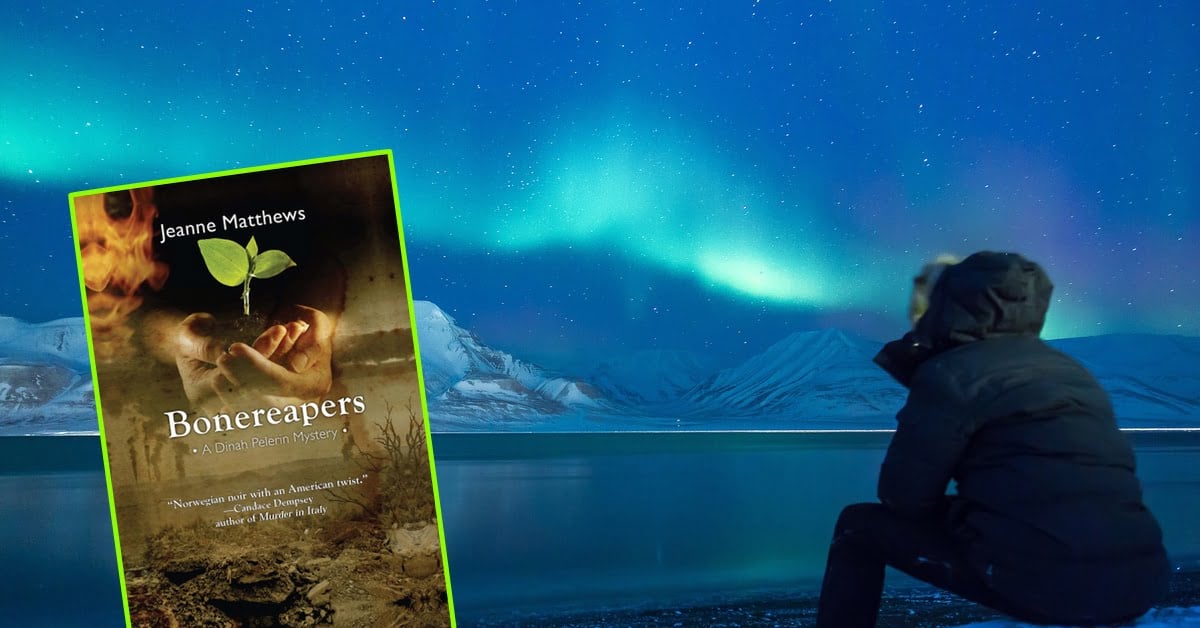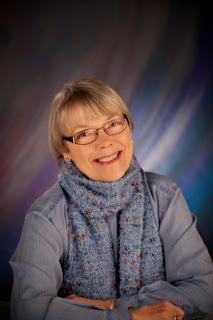
Bonereapers is a murder mystery set in the hostile environment of Svalbard. We chatted to author Jeanne Matthews about the book.

One of the fringe benefits of writing a guidebook for a major publishing house is the opportunity to meet other authors.
Jeanne Matthews is the author of the Dinah Pelerin international mysteries published by Poisoned Pen Press, including Bonereapers, set in the Norwegian Arctic at the site of the Doomsday Seed Vault.
Like her anthropologist sleuth, Jeanne enjoys traveling around the world learning about other cultures and mythologies, which she incorporates into her novels. Born and raised in Georgia, she currently lives with her husband in Renton, Washington.
Order Bonereapers now from Amazon
Can you give us an idea of what to expect in the book?
My amateur sleuth, cultural anthropologist Dinah Pelerin, is recruited to accompany three American senators and a powerful agribusiness mogul on a politically motivated trip to Svalbard. Senator Sheridan, a candidate for president, has brought along his Norwegian-born wife, a former pop singer with a secret past. When an environmental protester is murdered, Dinah is thrust into a maelstrom of lies and deceptions, some political and some deeply personal.
Suspicions abound. Who do the senators represent? What does the mogul really want? What if his biotech company were to gain access to the seeds, manipulate their DNA, patent the new hybrids as their exclusive intellectual property, or render them sterile so that farmers would have to buy the seeds over and over again with each new planting season?
While getting a crash course in the political controversies surrounding genetic engineering and the idiosyncrasies of the local culture, Dinah discovers a tangle of insidious motives. She joins forces with a sexy Sami policeman to investigate, but when a second murder victim tumbles out of the hotel sauna into her arms, she fears she might be the one to take the fall. She knows she’ll have to uncover the murderer fast or suspicion will come crashing downhill like an avalanche and bury her so deep she’ll never see daylight again.
What was it about the Svalbard Global Seed Vault that inspired you?
By some estimates, 75% of the earth’s plant varieties have gone extinct in the last hundred years and food security is a hot topic among scientists and politicians. Temperatures around the globe are increasing, deserts are spreading, and wars continue to create food shortages and famines. The Norwegian government conceived the vault as a sort of Noah’s Ark for the world’s threatened agricultural heritage. Cold slows the ageing process of seeds and prolongs their ability to germinate and Norway has an abundant supply of cold weather.
In 2008 they hollowed out a frozen mountain on the Arctic island of Spitsbergen and invited seed donations from every country in the world. The vault’s designers claimed that it would protect the seeds from biological degradation, rising seas, disease pandemics, nuclear holocaust, and even hurtling asteroids for the next 10,000 years. In all of my books, setting tends to create the plot and the “Doomsday Vault” intrigued me.
It’s the mystery writer’s job to imagine what can go wrong and this amazing facility sounded almost too good to be true. History is rife with impossible-to-predict events. There’s always some blip the experts never see coming and anything called the “Doomsday Vault” simply cries out for a murder. No fortress, however remote or ingenious, can protect against human corruption and those who have made it their business to gain control of the world’s food supply. That was the idea behind Bonereapers.
To what extent does the location play a part in the book?
The little hamlet of Longyearbyen where the vault is located is a very real character and a remarkable one. It’s the northernmost inhabited town in the world and so cold that, as a matter of public policy, it’s against the law to die there. Bodies don’t decompose in the permafrost and if a person feels sick enough to die, he is politely asked to fly south so he can be buried in softer soil. For four months of the year, the sun doesn’t appear above the horizon and the little town is wrapped in Polar Night.
I learned to my surprise that a few thousand years ago, the area was a steaming peat swamp where dinosaurs roamed. In 1901, the American industrialist Charles Longyear visited Spitsbergen and found coal deposits. He returned a few years later and opened a mining operation. The Norwegian labourers he hired named the place Longyear City.
Today, it boasts Santa’s Workshop inside an abandoned mine, the largest wine cellar in the world, and nearly as many polar bears as people. Everybody walks around armed with a polar bear rifle. All this and the Doomsday Vault, too! There couldn’t be a more interesting place to set a murder mystery.
Order Bonereapers now from Amazon
As a mystery writer, what’s your opinion on Nordic Noir and the Scandinavian obsession with the strange and mysterious?
It’s ironic that Norway and Iceland are among the most crime and corruption-free places on earth. Perhaps it’s the rarity of murder that whets the Scandinavian imagination. Norwegians devour crime fiction almost faster than it can be turned out, especially at Easter time. The tradition of påskekrim (Easter Crime) fascinates me.
In 1923, Easter fell on April 1st and as an elaborate April Fool’s joke, Nordahl Grieg and Nils Lie wrote a story about a robbery on the Bergen train during the Easter holiday. The publisher placed an ad on the front page of the Norwegian daily newspaper, BERGEN TRAIN LOOTED IN THE NIGHT!
It appeared as if it were headline news and believing it to be true, thousands of people called the train station to check on loved ones who had been on the train. That long-ago joke had a lasting impact and ever since, Easter has become the peak season to read crime novels. I think Norwegians must grow weary of all that lovely white snow and crave the novelty of a few bloodstains.
Who are your favourite other mystery authors?
It’s a very long list. The first mysteries I read were the so-called “classics,” mostly by British authors (Christie and Sayers) and they turned me into an addict. Raymond Chandler and Dashiell Hammett have to be included on the list. Nobody can match Chandler’s way with a simile – “as inconspicuous as a tarantula on a slice of angel food.”
I admire the humor and seemingly effortless storytelling of the late Donald Westlake. Reginald Hill is wonderful. I’m still furious with Sarah Caudwell for dying and I’m deeply jealous of Tana French’s extraordinary facility with language. My own books aren’t especially cozy, but they fall on the lighter, less gritty side of the crime fiction spectrum. In spite of murder, Dinah can still find situations and characters that make her (and the reader) laugh. By and large, Scandinavian authors are too bleak and fatalistic for me.
What were your favourite places to visit in Norway?
I loved the train ride from Oslo to Myrdal where we transferred to the funky little Flåm Railway and rattled down the mountain into Fläm. We hiked from the village to the top of a lovely waterfall (Brekkefossen) and rehydrated with several glasses of the local beer. The ferry ride on the Sognefjord to Bergen was delightful.
What was your scariest travel experience in Norway?
The ascent of Preikestolen was definitely the scariest. Pulpit Rock as it’s called in English is one of the most iconic images of Norway and one of the most spectacular sights anywhere in the world. This is a major photo op not to be missed. But for acrophobes like me, it’s a queasy experience – triumph mingled with terror.
It looks less like a pulpit than the prow of some immense ship. On three sides, sheer cliffs plunge 2,000 feet to the brilliant blue waters of Lysefjord below. There are no fences, no rails, nothing between you and the abyss. My husband and I literally crawled to the edge on our bellies to peer off into the fjord. The sight of other tourists perched on the precipice with their feet dangling over the rim made our blood run cold.
And then there’s the crack – the one right behind you that cleaves the rock from the mountain. You tell yourself, I’m standing on solid granite. This rock will be standing for centuries to come. Thousands have stood where I’m standing and lived to tell. And then you look down through that heart-stopping crevice into the depths below and decide, quite suddenly, that it’s time to descend. I snapped a hasty picture to prove I was there and started down.
Is Norway somewhere you could see yourself living?
In addition to the country being so beautiful, Norwegians enjoy an extraordinarily high quality of life. Every Norwegian citizen has free cradle-to-grave healthcare, free access to higher education, and a standard of living that is the envy of almost ever other nation.
And unlike most other nations, certainly unlike the United States, nobody hates the Norwegians. They’re just so darn nice. But in whatever locale I find myself, at home or abroad, I tend to be a contrarian. I’m not sure I’d fit in with all that niceness.

